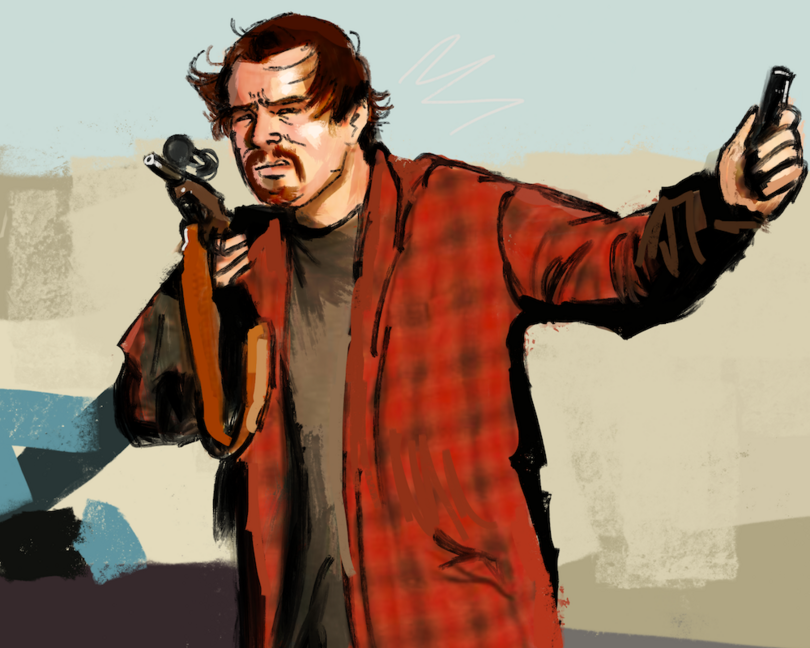Paul Thomas Anderson’s timely ‘One Battle After Another’ deserving of praise

Leonardo DiCaprio shines as the lead in “One Battle After Another.” It’s arguably one of the best performances of his career, our columnist says. Jalyn Cronkrite | Contributing Illustrator
Get the latest Syracuse news delivered right to your inbox.
Subscribe to our newsletter here.
During the thick of “One Battle After Another,” Bob Ferguson (Leonardo DiCaprio) — who sports a beanie, sunglasses and a red flannel robe — turns back before exiting a hallway and shouts, “Viva la revolución!” Like Bob, director Paul Thomas Anderson channels his revolutionary past to deliver something new.
Anderson’s 10th film, “One Battle After Another,” changes course from his usual work. It’s his first project since 2002’s “Punch-Drunk Love” to be set in modern times and is arguably his most digestible to date. Still, the film features Anderson’s signature tension, quirkiness and unsettling tone.
The politically driven comedy-thriller is an acting masterclass, led by one of DiCaprio’s finest performances. Complemented by an excellent score and inventive cinematography, “One Battle After Another” should have a field day at this season’s Academy Awards.
Bob and Perfidia Beverly Hills (Teyana Taylor) are members of the French 75, an American leftist revolutionary group. After the French 75 frees immigrants from a detention center in California, Bob and Perfidia begin a romantic relationship.
The center’s commanding officer, Col. Steven J. Lockjaw (Sean Penn), becomes obsessed with Perfidia. In a subsequent French 75 attack, Perfidia is caught planting a bomb, but Lockjaw lets her go in exchange for sex.
Later, to avoid prison for a failed robbery, Perfidia enters the witness protection program and rats out members of the French 75 to Lockjaw. Eventually, she escapes the program, fleeing to Mexico and leaving Bob with their baby daughter.
Sixteen years later, Bob and Willa Ferguson (Chase Infiniti) are hiding in the fictional town of Baktan Cross.
Lockjaw is invited to join a secret white supremacist group called the Christmas Adventurers Club. He lies to the society, saying he’s never engaged in an interracial relationship. In fear of Willa being his daughter (giving the group evidence of his relationship with Perfidia), Lockjaw and his troops head to Baktan Cross in search of Bob and Willa.
DiCaprio turned down the lead in Anderson’s 1997 “Boogie Nights.” He’s more than made up for it with his performance in “One Battle After Another;” it’s utterly fantastic and arguably the best of his career.
The list of great DiCaprio scenes is endless: the Lemmon Quaaludes in “The Wolf of Wall Street,” Calvin Candie’s sliced hand in “Django Unchained” and the improvised whiskey sours meltdown in “Once Upon a Time… in Hollywood” to name a few. Now joining the list is Bob’s freakout on the phone with a member of the French 75.
While trying to get coordinates for a rendezvous point, he can’t remember part of the organization’s cryptic password and loses it on the other line. I was hysterically laughing in the theater; DiCaprio’s delivery and facial expressions uplift an otherwise heavy script.
Like Anderson intended, I hated Lockjaw. He was slimy, creepy, perverted and tyrannical, but Penn played him perfectly. I’d be surprised if Penn doesn’t hoist the Oscar for Best Supporting Actor in March.
The most impressive performance, however, is Infiniti’s. In a flick full of veterans, she fits right in. Despite this being her first role in a feature film, Infiniti exudes confidence, a reflection of herself and her character. Anderson trusted Infiniti for a reason, and “One Battle After Another” is just the start of what could be an incredible career.
The best scene by far is an epic car chase featuring Bob, Willa, Lockjaw and Tim Smith (John Hoogenakker), a member of the Christmas Adventurers Club. Spectacular action and plot twists made my jaw physically drop three separate times during this part of the film.
Still, the most memorable part of the climax isn’t the tension or performances, but the cinematography, aided by higher quality visuals from the VistaVision format.
Shot near U.S. Highway 78 in Borrego Springs, C.A., Anderson and cinematographer Michael Bauman used low camera placement to emulate the view of a phone sitting on a car dashboard.
The result is a sprawling sequence that takes the audience up and down the river of hills (how the crew refers to the highway). You feel like you’re in the passenger seat, going over bumps — a sinking feeling in the pit of your stomach included.
My only complaint with “One Battle After Another” is that the phone freakout and climax are easily the two standout scenes. At other times, the picture felt underwhelming.
But even with the runtime of 2 hours and 41 minutes, Anderson kept my attention throughout. Most of the film’s comedy works well, thanks to DiCaprio and the ever-reliable Benicio del Toro as Sensei Sergio St. Carlos.
“One Battle After Another” is composer Jonny Greenwood’s sixth collaboration with Anderson, and his magnificent score is complimentary to Anderson’s style, feeling frightening and urgent. The score, along with wonderful song choices like “Dirty Work” by Steely Dan and “Ready Or Not (Here I Come)” by The Jackson 5, contributes to the eccentric atmosphere.
I think rewatching this film will only enhance my experience. The 55-year-old director started writing the script 20 years ago. In an interview with Letterboxd, Anderson said it feels ironic; American life and political elements haven’t really changed much over the past two decades.
Among the obvious messages of fatherhood, Anderson displays layered themes like political violence, immigration and white supremacy. While the French 75 is a revolutionary group, Anderson isn’t condoning political violence; it’s the backdrop. I admire his approach, weaving topics into the narrative rather than shoving them in your face.
In the end, Christmas Adventurers Club gifts Lockjaw an office. The scene feels exactly like Tommy DeVito’s (Joe Pesci) death in “Goodfellas,” but instead of being shot, Lockjaw is gassed in the office and incinerated. It feels purposeful; Lockjaw’s death parallels Nazi tactics, reinforcing the club’s white supremacist ideology.
My immediate reaction was that “One Battle After Another” was great (not a term I use lightly), but I was ready to call it overhyped. While I’m not quite ready to add it to my favorites list, with a few days of marination I can confidently say DiCaprio and Anderson’s first collaboration is deserving of its praise.





